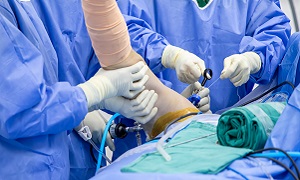Best Bankart Repair Surgery Doctors in India
Best Bankart Repair Surgery Hospitals in India
- City: Bengaluru, India
Hospital Highlights:
- Fortis Hospital Bannerghatta, Bengaluru was established in 2006.
- The hospital is a 276 bedded multi-specialty tertiary care facility.
- The hospital specializes in cutting-edge medical technology and dedicated patient care services.
- The hospital is equipped with state-of-the-art technologies like trans-radial angioplasty, trans-abdominal cardiac surgery, and computerized TKR navigation surgery.
- The hospital provides specialty medical services in cardiology, cardiac surgery, orthopedics, neurology, neuro-surgery, GI, and Minimal Access Surgery (MAS).
- City: Chennai, India
Hospital Highlights:
- Fortis Malar was established in 1992 and was formerly known as Malar Hospital.
- The hospital specializes in cutting-edge medical technology and dedicated patient care services.
- The hospital is multi-specialty, tertiary care facility with 180 beds.
- The hospital offers comprehensive medical care in specialties such as cardiology, cardio-thoracic surgery, neurology, neurosurgery, orthopedics, nephrology, gynecology, gastroenterology, urology, pediatrics, and diabetes.
- City: New Delhi, India
Hospital Highlights:
- Established in 1996, Pushpawati Singhania Research Institute is one of the top hospitals in the NCR region, as well as one of the top facilities in India for gastroenterology. The hospital is one of South Asia’s first institutes in medical and surgical treatment for diseases related to digestion.
- The hospital is equipped with state-of-the art facilities coupled with the latest equipment as well as renowned consultants from various parts of India as well as other parts of the world.
- City: New Delhi, India
Hospital Highlights:
- State-of-the-art technology and devoted healthcare professionals have been brought together under one roof at Venkateshwar Hospital to provide genuine medical care. The hospital’s professionals work together as a team to deliver the best possible treatment to their patients, using the most sophisticated equipment and information technology.
- Venkateshwar Hospital’s mission is to attain global excellence in healthcare by employing evidence-based, ethical clinical practices and cutting-edge technology by a team of highly skilled experts.
- City: New Delhi, India
Hospital Highlights:
- Sir Ganga Ram Hospital, New Delhi is known to provide the latest medical procedures with the latest technology in all of its units.
- The hospital has a team of reputed doctors, nurses, and healthcare professionals that ensure that patients receive quality care at affordable costs.
- Staffed with a team of highly qualified doctors, dedicated nurses, and paramedical and non-medical staff, the hospital aims to lead in healthcare delivery, medical education, training, and research.
- As per the vision of the founder, the hospital also provides free treatment to the economically weaker sections of society.
- Sir Ganga Ram Hospital also provides training to young doctors under the Diplomate in National Board(DNB) program. The DNB program at the hospital was started in 1984 and it is known for currently running the maximum number of DNB specialties in the country. It also has the distinction of having the first bone bank in India.
- City: Kerala, India
Hospital Highlights:
- Established in 2019, Apollo Adlux Hospital is the first Apollo Hospital in Kerala and the 73rd hospital owned by Apollo Group in India. With the state’s most advanced, comprehensive healthcare infrastructure and cutting-edge technologies, Apollo Adlux Hospital stands as an example of medical excellence in Kerala.
- With over 34 multi-specialty departments, the hospital believes in providing the best quality treatment to its patients at affordable rates, ensuring comfort at their difficult times.
- The 300-bed hospital is managed by a team of highly qualified and experienced experts who delivers exceptional hospitality to their patients and treats them with great compassion.
- With its affiliation with the Apollo Hospitals Group, the hospital aims in providing patients with top-notch healthcare services while also serving communities in Kerala.
- The hospital has good railway and road connections, and is conveniently close to Cochin International Airport.
- City: Gurugram, India
Hospital Highlights:
- Situated near DLF Cyber City, Gurugram, Narayana Superspecialty Hospital is one of the top medical facilities in the Delhi NCR region, catering to the needs of the people. Known for its commitment to quality medical care and patient service, the hospital is a state-of-the-art facility with planned and well-equipped sections, which includes a spacious OPD area as well as comfortable patient rooms.
- It is the closest super-specialty hospital from Indira Gandhi International Airport towards Gurugram, and also the nearest super specialty hospital from DLF Cyber City. It is also close to major residential areas in Gurugram.
- It is part of the renowned Narayana Health Group. Established in 2000, by Dr. Devi Shetty, a renowned cardiac surgeon, it has grown to be one fo India’s leading healthcare groups.
- City: Noida, India
Hospital Highlights:
- Fortis Hospital, Noida, stands as one of the oldest and most trusted healthcare institutions in the region, setting a benchmark for comprehensive medical care.
- As the second mega hub hospital in the Fortis Healthcare Group, Fortis Hospital, Noida, upholds a legacy of trust among more than 1.2 million patients. By integrating top-tier professionals with cutting-edge technology, the hospital delivers superior treatment across various medical disciplines.
- Specializing in advanced Neurosciences, Orthopedics, Kidney and Liver Transplant Programmes, Fortis Hospital, Noida has successfully performed over 1,500 transplants, solidifying its reputation as a leader in specialized medical interventions.
Bankart Repair Surgery
The Bankart Repair Surgery is often recommended by a doctor in case of a shoulder dislocation or instability in order to repair or restore proper functionality of the shoulder joint. Doctors usually prefer the Arthroscopic approach, a minimally invasive procedure which means only a small surgical incision is made to diagnose and rectify the shoulder joint problems.
Primary cause of shoulder pain
The shoulder primarily contains three bones, namely,
- The clavicle or collarbone
- The scapula or the shoulder blade
- The humerus or the upper arm bone
The shoulder joint is cushioned by articular cartilages, soft tissues, rotator cuff and labrum. Disruption, damage or tear in any of the above including muscle or cartilage wear and tear caused due to old age may be the primary cause of pain. During arthroscopic surgery, doctors insert a small device attached to a camera into the shoulder to determine the exact cause of pain.
What are the symptoms of shoulder injury?
- Excessive pain in shoulder joint
- Pain in the upper arm
- Stiffness and restricted movement in shoulder joint
- Insomnia caused by pain and stiffness
- Swelling and redness around the shoulder area
Investigations & surgery decision
At the initial stage of diagnosis, doctors usually recommend basic physical examinations, such as Anterior Apprehension Test or Load and Shift.
Other diagnosis treatments may include X-rays, MRI or MRA. The treatment methods recommended are in the form of physical activity, physiotherapy and medicines. If the shoulder pain remains persistent or unresponsive despite the alternative treatments, doctors recommend Arthroscopic Bankart Repair Surgery as a diagnosis and treatment method.
Benefits of Arthroscopic Bankart Repair Surgery
The Arthroscopic approach to Bankart Repair Surgery is often preferred over alternative treatment methods due to its many advantages, some of which are
- Less surgical morbidity
- Reduced surgical costs
- Short-term rehabilitation
- Reduced postoperative pain
- Improved cosmesis
How is the Arthroscopic Bankart Repair Surgery performed?
Bankart Repair Procedure
The Arthroscopic Bankart Repair Surgery focuses on the labrum, which is a cartilage band attached to the glenoid bone in our shoulders. The main aim of the surgery is to provide comfort from the progressive pain along with proper functioning of the shoulder to allow patients to perform day-to-day basic activities without pain or discomfort.
Preparation for the surgery
- Your doctor will help you out with a dietary chart of what to eat or drink and what to avoid before and after your surgery. Make sure you strictly adhere to the dietary regulations set by your doctor.
- Bring all your necessary medical documents including blood test results, X-ray reports and scans and hand it over to the healthcare professional.
- Please ensure you have a family member or a friend accompanying you for the procedure and helping you with your ride back home.
The surgery
Insertion of Arthroscope
The surgeon initiates the surgical process with a small incision made at the front of the shoulder and another one at the back of the shoulder. A small video camera also known as an arthroscope is inserted through the incision to view the inside of the joint post which small surgical instruments are inserted to further the procedure.
Prepping the Area
Once the surgeon gets a clear shot, the area around the labrum is thoroughly cleaned by the surgeon, ensuring no loose particles or sharp edges remain.
Placement of Anchors
The next step is to drill small holes in the bone where anchors are placed. These anchors are used to hold the sutures in place around the glenoid.
Re-attachment of Labrum
While the anchors hold the sutures in place, the surgeon attached the labrum to the sutures and pulls the sutures tightly in order to reattach the labrum to the glenoid.
The surgery ends with the incisions being cleaned and covered and the patient is usually put in a sling post-surgery for recovery at the initial stages.
Hospital stay and recovery time
The surgery procedure takes about 1-2 hours and a minimum 24hr hospital stay is needed to monitor your recovery rate post which you are free to go home. The initial recovery phase is estimated to be 3-6 weeks wherein doctors advise patients to wear an arm sling for protection and safety reasons. The following recovery phase starting from 4-8 weeks after the surgery is focused on flexibility of movement. However, the total recovery time may vary from 4 or 6 months to 1 to 2 years after the surgery.
Post-surgery precaution & care
Apart from the follow-ups and the prescribed medicines, you will be asked to actively participate in proper precaution and care after your surgery for a quick and steady recovery.
Points to keep in mind
- Please wear your sling for at least 3-6 weeks from the date of your surgery and only remove the sling on your doctor’s approval.
- You should routinely remove the sling for time to time at least thrice each day to stretch or straighten the elbow. This is important to avoid stiffness or joint lock.
- Do not apply ointments, creams or wet tissue/ dressing on the wound unless advised otherwise by their doctors.
- You should ask your doctor for approval before showering post-operation and even when you do, you should strictly avoid scrubbing or spraying the wound area. Gently pat it dry, preferably with an antiseptic cotton pad and air-dry it before putting the wound dressing back on.
- You should strictly avoid any form of heavy physical work, especially something that has to do with elbows, arms or lifting for at least 4-6 months from your operation.
- Ask your doctor or healthcare professional for a detailed diet list including restrictions such as no smoking or no alcohol clearly mentioned and then strictly abide by it.
FAQs
What is a Bankart tear?
Shoulder dislocation may cause a tear in the shoulder cartilage which is commonly known as the labrum. This tear in the labrum is commonly known as Bankart tear and can be fixed through the Bankart Repair surgery.
How long do I have to wait to return to work after surgery?
Returning to work after surgery depends on a lot of variable factors like the type of job you do, the amount of physical exertion you might face at the job, your body’s reaction and recovery rate and more. Doctors usually advise taking 2 weeks off work if you have a job that requires no physical activity.
When can I begin physiotherapy?
You can start with your physiotherapy within a week or two of your surgery.
What happens if I’m not feeling well after surgery?
Call your surgeon or family doctor, if you’re experiencing any of the below-
- Increased pain and swelling
- Pussing or leaking from your wound
- High fever and constant nausea
- Inability to pass urine for more than 8-10 hours











